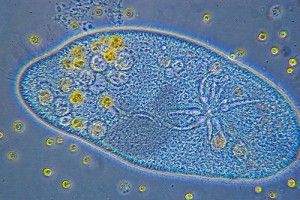Light for Cellular Communication?
Don't you know We're all light Yeah, I read that someplace --XTC
This is interesting: an article in PLoS ONE that claims that Paramecia can communicate using light. The author, Daniel Fels from the Swiss Tropical Institute in Basel, separated two Paramecia populations using quartz or glass vials, grew them in the dark, and checked whether the separated, but close populations, affect each others growth and feeding rates. The correlation he found was strong. Large populations in one vial affected the growth rate of small populations in the adjacent vial.
The main problem I have with this study (and similar ones he cites) is that the evidence is mostly negative: i.e. by eliminating other possible causes, he arrives at the conclusion that the only probable signalling mechanism is self-emitted light. Fels controlled for other ambient effects such as heat and diffusion by evaporation. Also, he used glass and crystal vials in different experiments, and has shown that results differ depending on the vial material. Since glass and crystal filter different wavelengths this was interpreted as having at least two different wavelengths convey signals. (one spectrum above 340nm, and the other below). However, Fels did not directly detect the proposed photons. The claim is that the electromagentic radiation is too weak to be picked up by external sensors. But I believe there are microsensors that are sensitive to single-photon emissions that could be used in the medium. Nor did he use an independent source of photons to simulate the population radiation. Again, something I believe can be tried.
Apparently this is not the first study of the mysterious and elusive (or non-existent?) biophotonic activity: Fels cites a whole slew of previous studies, in the same vein, conducted with yeast, onion roots and some animal tissue cells. The emerging picture is that there may be such a phenomenon, but it hasn’t been shown directly, yet.
Anyhow, here is a FriendFeed discussion I started, (update: I removed the framing of the FriendFeed discussion from this post since it went from discussing science, to discussing discussions) You are welcome to comment here, or better yet, in the comments section in the PLoS ONE article itself (login required).
This article has< been slashdotted. Exercise extreme caution.
Fels, D. (2009). Cellular Communication through Light PLoS ONE, 4 (4) DOI: 10.1371/journal.pone.0005086





















Extraordinary conclusions require extraordinary evidence. You are exactly right: if the author wants to show that communication is light-based, he at a minimum needs to show that photons are being emitted, and preferably that the same photons can have the observed effect. We understand how to detect and generate these particles–this is really not too much to ask.
I find it interesting that the author chose to use UV wavelengths for comparison. I would expect more interesting interactions within the infrared. Infrared photons require lower energy to produce, and would be a more – probable transition – than UV. However – infrared is less likely to cause an electronic transition in the molecules that it is incident on. What kind of signaling mechanism would it be in the end? Some vibrational state for what, OH bonds? heh I’ll read the article first I guess.
“I believe there are microsensors that are sensitive to single-photon emissions that could be used in the medium”
Yes, you are correct. These type of detectors are called “photomultiplier tubes”, or PMTs for short. They are frequently use for doing single-photon detection. Hamamatsu is a large manufacturer of such devices. Wikipedia has a good writeup here: http://en.wikipedia.org/wiki/Photomultiplier
It seems a bit ridiculous that the researchers involved in this project would have used such a device to directly measure the (possible) photon output from the Paramecia.
Er, how about simply repeating the test with various blockers in the middle (black index card, red filter, IR filter, etc)? I wouldn’t even publish without narrowing it down to something specific. Otherwise, it could be anything (maybe they sense the vibrations from the other colony.)